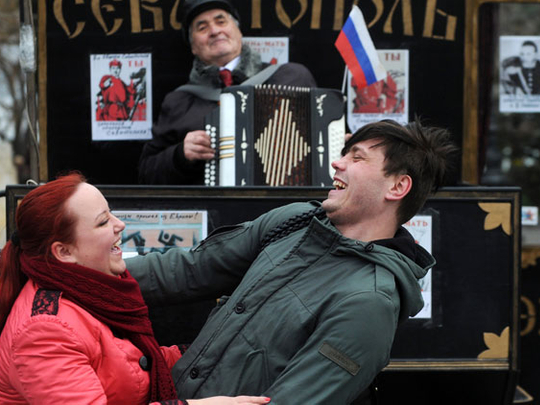
With Crimea in Russia’s pocket, the world anxiously awaits Vladimir Putin’s next move. Beyond the prize of the Black Sea peninsula, a picture is emerging of what the Russian president ultimately wants from his power play: broad autonomy for Ukraine’s Russian-speaking regions and guarantees that Ukraine will never realize the Kremlin’s worst nightmare — joining the North Atlantic Treaty Organisation.
Why does Russia have a naval base in Crimea?
Russia’s capacity to reach the sea is limited by geography, so ports in the north and south seas, leading to larger waters, are crucial. Sevastopol is a strategically important base for Russia’s naval fleet, in addition to being Russia’s only warm water base. After the dissolution of the Soviet Union, a 1997 treaty with Ukraine allowed Russia to keep its Black Sea Fleet pretty much intact (with 15,000 personnel currently stationed) and lease the base at Sevastopol (extended to expire in 2042). The Treaty of Friendship and Cooperation – by which Russia rents its naval base at Sevastopol from the Ukrainian government – is so far-reaching in the rights it gives the Russians to exercise their military powers that it is seen by many in Ukraine to undermine the country’s independence. In 2008 the Ukrainians said they would not renew the lease when it expired in 2017. But they buckled under the pressure of a gas-price hike and, in 2010, extended the Russian navy’s lease until 2042.
Projecting power from the Crimean peninsula
Sevastopol has been an important hub to project Russia’s naval power on a global platform. The Black Sea Fleet has seen a flurry of activity since 2008: during the war with Georgia that year, the fleet staged blockades in the Black Sea. The Russian navy was actively engaged with Vietnam, Syria and Venezuela (and up until March 2011, Libya) “for logistics and repair services in their principal ports”. It has also been alleged that Sevastopol has served as the main source in supplying the Assad regime during Syria’s civil war and proved useful with Russia’s role in dismantling Syria’s chemical weapons last year. After Syria’s civil war forced Russia to stop using its naval base in the Syrian port of Tartus last year, Sevastopol became even more crucial.
Crimea and Crimean Tatars
For five hundred years — roughly the middle ages in Europe — Turkic and Tatar tribes traded rule of Crimea. The peninsula spent a few hundred years as a Muslim Khanate and then an Ottoman vassal state, until Russia annexed it in 1783, under Catherine the Great, who thought the region symbolised Russia’s links to antiquity. (She proceeded to parcel out land to aristocrats and build classical-style palaces and gardens.)
By 1900, the Crimean Tatars, once the majority, had been halved by wars and campaigns of Russification. Their population was halved again in 1917, and shortly after that, Stalin forcibly deported most of the remaining Tatars to central Asia. Unsurprisingly, Tatars have largely held fiercely anti-Russian sentiments for a very long time. Since the collapse of the Soviet Union, Tatars have been returning, and though they number upwards of 200,000, they’re still a minority.
The British and the Crimean War
With its Black Sea fleet based in Sevastopol, Tsar Nicholas I knocked the Ottoman Empire out of the region — a hugely symbolic feat considering Russia’s tricky relationship with its Muslim population and its centuries in need of a fleet. But Nicholas’ overconfidence in Crimea in part led to the Crimean war with Britain and France, whose leaders sought to stop Russia’s expanding borders and to slow its influence in the Middle East. The allies won the war, bestowing British culture with the Charge of the Light Brigade, Florence Nightingale and Timothy the Tortoise. The Russians lost, but Tolstoy’s Sevastopol Sketches made sure that the 11-month siege of Sevastopol stuck in the national memory. (Between Sevastopol in 1854 and Leningrad in the Second World War, the notorious Russian “siege mentality” may begin to make sense.)
From Khrushchev to Yeltsin
Crimea was given to Ukraine by premier Nikita Khrushchev (himself born at the border with Ukraine) to mark the 300th anniversary of Ukraine’s inclusion in the Russian Empire, a “donation” many in Russia still see as illegitimate. Surprisingly, Boris Yeltsin, the first president of post-Soviet Russia, didn’t propose an acquisition of Crimea during negotiations to dissolve the Soviet Republics.
Peter the Great changed the history of Crimea
Peter the Great changed the course of history in countless ways, and was an extremely strange man and very serious about boats. (He supposedly said “A great leader who has an army has one hand, but he who has a navy has two.” As a child, he would order around the children of other noblemen as “regiments” pretending to prepare for war. As an adult, he built a small boat by hand and used it to sail across the Neva, the river that runs through St Petersburg.) After a long trip in his youth to western Europe, in particular Amsterdam, where he studied shipbuilding, he returned to Moscow obsessed with dragging Russia into modernity — and making it a rival of the nations he saw in Europe.
Peter saw Russia’s limited access to the ocean as one of its greatest weaknesses, and though it meant tens of thousands of dead serfs to build a city on a unforgiving swamp, he had St Petersburg built on the Gulf of Finland for this very reason: he would reach the sea at every opportunity. With his new northern capital giving access to the Baltic, Peter countered the power of his arch-rival, King Charles XII of Sweden. (To give you an idea of how deep-seated the contest over Ukraine is, Peter defeated Charles’ attempt to conquer Ukraine at the 1709 battle of Poltava.) To the south, Peter fought wars against the Tatars (who else) to gain access to the Black Sea, and built Russia’s first naval base in Taganrog in 1698.












